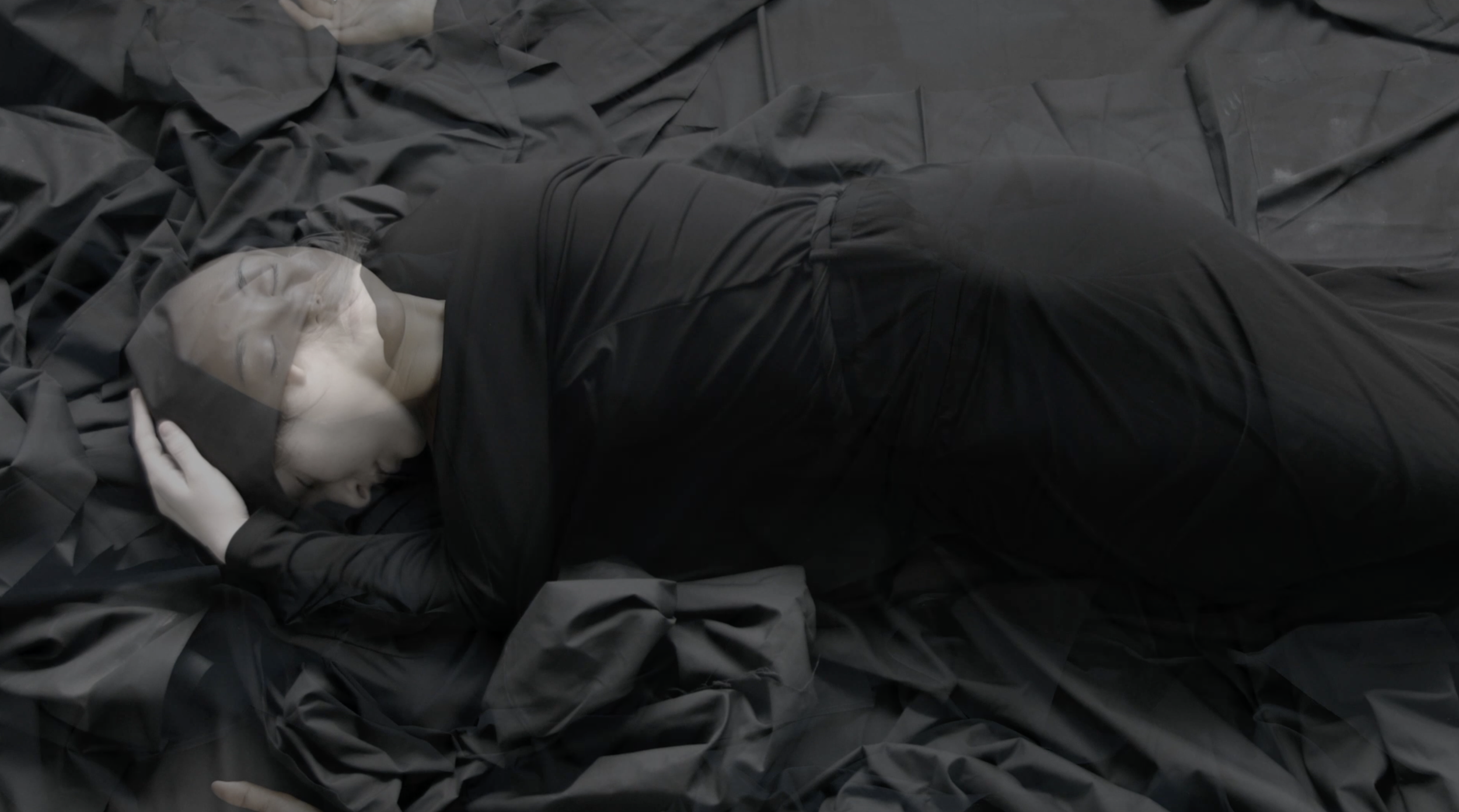Nirbhaya Projections
above: still from Nirbhaya (Projections), 2020-, 4K digital film, silent & sound. Movement performer: Disha Harjani
Nirbhaya (Projections)
2020-
4K film, color, sound and silent
duration: 30 minutes 20 seconds (part 1), limited edition, 3 + 2 AP
limited edition c-prints (film stills), dimensions variable, edition of 3 + 2 AP
above: excerpt from Nirbhaya (Projections), 2020-, 4K digital film, silent & sound. Movement performers: Katherine Justelle and Jueun Kang. Sound (Metamorphosis, 2021) composed by the artist
below: selected limited edition film stills
Credits
film, sound, and movement directed, filmed, composed, choreographed, and edited by Monika Weiss
movement performers: Rosemary Carroll, Melissa Gollance, Katherine Justelle, Jueun Kang, Eliana Rowe, Alexa Velez and the artist
Artist Statement
The silent film projections show a woman lying down on a bedding of layers of black cloth, wearing a black shroud and veiled, moving extremely slowly. Her eyes are closed, her hands cover and uncover her face. She gradually ties and unties her black scarf, enacting gestures of lamentation. Seen by the viewer in a horizontal position, the protagonist seems to be immersed in a space behind specific location or history, perhaps becoming one with Earth, becoming landscape.
I choreographed and filmed women volunteers who came to my studio to contribute their presence and image to the project which seeks to honor victims of gender based violence. The slowness of their movement is real. The extremely slow tempo and the resulting intensity of presence was captured by my camera, presented in the final work without editing. I edited only by adding gradual layers, suggesting concurrent and alternative realities coexisting in one image, to evoke states of transformation.
Thanks to film montage, over time, one woman gradually morphs into another, eventually transforming herself into a tree. This transformation is represented symbolically, through my abstract drawings. Evoking the moment in which Daphne escapes the violence of rape by self-transforming into a tree, the filmed drawings become another layer in the projection, enshrouding the living body of a woman and transforming her skin into a bark. While Daphne dies as a woman, she also becomes a living body of a tree.
Suggesting a connection between the violence against women and the devastating actions against the natural environment, this cycle of silent projections have been shown in a number of exhibitions and screenings, accompanied by sound composition Metamorphosis (2021). The projections will be included in the monument/antimonument Nirbhaya, honoring victims of gender based violence, and planned as a long-term public project at Dag Hammarskjold Plaza, near United Nations, New York.
- Monika Weiss
Essay Excerpt
I want to argue the Monika Weiss’ work challenges us precisely because it has not become merely symptomatic, a hysterical disarticulation. Moreover, her work is not about recovery. Nor does it offer belated accounts of states of dispossessing extremity. Indeed, I am arguing that her artworking is a rhetoric she has created for a continuous present that is realized in a formalized, aesthetically intense, audio-visual musicality that, even as its chosen terms are body, sound, gesture and movement, avoids all melodrama in its gestural form, refutes all hystericization of the body, and does not silence language. Hence it does not still thought.
Thus, while quoting French philosopher Jean Luc Nancy on the Sublime, Austin suggests that lamentation moves ‘toward an abyss of language… overwhelmed with the idea of loss rather than the lost object’, I think, on the contrary, that we are confronted in the Nirbhaya precisely with a form of making present something radically other than both loss and the lost object.
I have been purposely weaving a series of points of entry to Nirbhaya, a work whose narrative occasion might well mislead us to think we are being invited to mourn one truly appalling death in the city of Delhi in 2012, feeling horror at the extreme suffering and torture that preceded it. We might reduce the monument and its related sounds and video cantos to being elegies or laments for one death, or even the many deaths of which this one might become the symbol.
Lamentation and the lament are indeed occasioned by death, destruction and loss. Art is, however, a transformation of the occasioning event into an aesthetic formulation that aims to act on its viewers and listeners on behalf of life over time. Lamentation at the graveside or before the funeral pyre is for the intimate mourners of the person who is now dead. An artwork produces a constant present of the now-encounters for each unknown person who comes to the site. It can become a ‘transport station of trauma’. This is a crucial concept that I draw from the writings and artworking of the artist Bracha L. Ettinger about her own work but also many artists also confronting the legacies of history through art. [read full text here]
Griselda Pollock “The Fidelity of Memory in an Endless Lament. Nirbhaya, New Delhi, 2012, and Now…” in Monika Weiss-Nirbhaya, Centre of Polish Sculpture in Orońsko, 2021, pp. 12 - 50
Exhibitions
Nirbhaya (Monument/Antimonument), Dag Hammarskjold Plaza, New York, in cooperation with New York City Parks (forthcoming)
Monika Weiss-Nirbhaya, John Jay College of Criminal Justice, City University of New York, 2023, curated/moderated by Claudia Calirman (forthcoming in November)
Monika Weiss - Metamorphosis | Nirbhaya, Infrequent Seams, New York, 2022 (release), curated/moderated by James Ilgenfritz
Bliss, YCG Gallery, New York, 2022, curated by Yassana Croizat-Glazer
Monika Weiss-Metamorphosis|Nirbhaya, Bruno David Gallery, St Louis, 2021-2022, curated by Bruno David
Double Infinity: A Celebration of Phill Niblock's 88th Birthday in 88 Quarter-hours, Experimental Intermedia Foundation, New York, 2021, curated by Katherine Liberovskaya, Daniel Neumann and Bob Bellerue
emerging.poetic, Brick City Gallery, University of Missouri, Springfield, 2021, curated by B. Colby Jennings
Publications
Monika Weiss-Nirbhaya, Centre of Polish Sculpture in Orońsko, 2021











